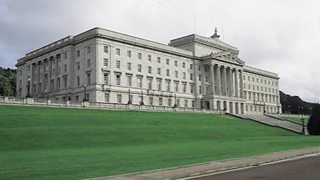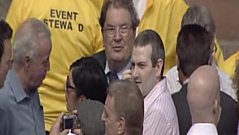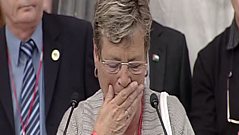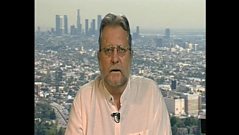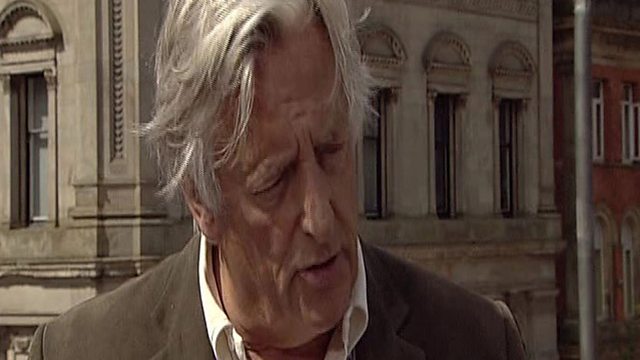
Michael Mansfield responds to the Saville report
Michael Mansfield QC, barrister for three victims’ families and four victims in total, responds to Lord Saville’s just published Bloody Sunday report.
On the day that Lord Saville’s report into the events of Bloody Sunday is published (please see context below) Jim Fitzpatrick anchors a special Stormont Live programme.
Here, Jim hands over to Political Editor Mark Devenport in Londonderry’s Guildhall Square. Mark is joined by Michael Mansfield QC, one of the barristers for the victims’ families at the tribunal. Mr. Mansfield represented three families and four victims in total.
On behalf of the families that he represented Mr. Mansfield states that Lord Saville’s report has lived up to their expectations in terms of the vindication of the victims.
He adds that his clients are expecting the Director of Public Prosecutions to look at the evidence contained in Lord Saville’s report: “They’re not seeking blood, I have to say straightaway, but they want the course of justice to follow, as this has done – and so therefore they are expecting it will be considered, and what happens after that is a matter for them”.
Mr. Mansfield cites the case of Soldier F; he shot Barney McGuigan who was holding up a piece of white material to try and stop the shooting. The original evidence of Soldier F was found by Lord Saville to be false: “Therefore, clearly, there is material to be considered by the Director of Public Prosecutions”.
When asked about how other victims of the Troubles must be feeling today, Mr. Mansfield makes a distinction between sectarian murders and the unlawful killing carried out by agents of the British state on Bloody Sunday: “We do not expect that people who are empowered and authorised to keep the peace will break the law in this way”.
Mr. Mansfield compares this occasion with the public inquiry into the murder of Stephen Lawrence (the black British teenager who was stabbed to death on 22 April 1993). Here too there was a huge public response and a great feeling of relief that the truth had been told: “It’s what’s been missing in our democracy, accountability and truth, and these inquiries actually come up to the mark”.
CONTEXT
On 30 January 1972 soldiers from the 1st Parachute Regiment killed 13 innocent civil rights demonstrators in Derry.
The period from August 1971 to January 1972 saw a sustained campaign of anti-internment protests. On 22 January, John Hume led an illegal demonstration along Magilligan Strand just outside Londonderry, towards a nearby internment camp. The marchers were confronted by soldiers of the 1st Parachute Regiment who drove them off the beach using baton charges and rubber bullets.
It was these same paratroopers who were sent into Derry eight days later to deal with another banned protest. This march was organised by the Northern Ireland Civil Rights Association (NICRA). Some ten thousand people gathered in the Creggan estate and proceeded towards Guildhall Square in the centre of the city. The paratroopers had sealed off the approaches to the Square and the march organisers, in order to avoid trouble, led most of the demonstrators towards Free Derry Corner in the Bogside.
Groups of local youths (referred to by the security forces as ‘YDHs’ – Young Derry Hooligans) stayed behind at the Army barricades to confront the soldiers. The soldiers were ordered to move in and arrest as many of the rioters as possible. Just after four o'clock, the paratroopers made their move. What took place next was totally unexpected: the paratroopers opened fire on the crowd, killing thirteen men and injuring thirteen others; one of the injured died some time later.
The soldiers claimed that they had been fired on as they moved in to make arrests. As far as the people of the Bogside and further afield were concerned, the Army had summarily executed thirteen unarmed, innocent civilians. The Widgery Tribunal, which had been set up to investigate the circumstances surrounding the killings, later concluded that: ‘At one end of the scale, some soldiers showed a high degree of responsibility; at the other end.... firing bordered on the reckless’.
The Londonderry Coroner, Major Hubert O'Neill, did not share Lord Widgery's conclusion. At the end of the inquest in 1973, which is still seen by nationalists as a cover up for murder, O'Neill said, “It strikes me that the army ran amok that day and they shot without thinking what they were doing… I say it without reservation - it was sheer unadulterated murder”.
The British government later made out-of-court settlements with the bereaved families
In 1998 the Labour government launched an in-depth investigation chaired by Lord Saville of Newdigate. The Saville Inquiry, which was the most expensive investigation of its kind in the United Kingdom, reported in June 2010.
It concluded that none of the dead posed a threat and the actions of the soldiers were totally without justification. The Prime Minister David Cameron apologised on behalf of the nation for the “unjustified and unjustifiable killings”.
Duration:
This clip is from
More clips from Stormont Live Special - The Saville Inquiry Report
-
![]()
Publication of Saville Report
Duration: 11:42
-
![]()
Relatives of Bloody Sunday victims
Duration: 27:09
-
![]()
Early political reaction to the Saville report
Duration: 09:16
-
![]()
Interview with Tony Clarke
Duration: 03:41
